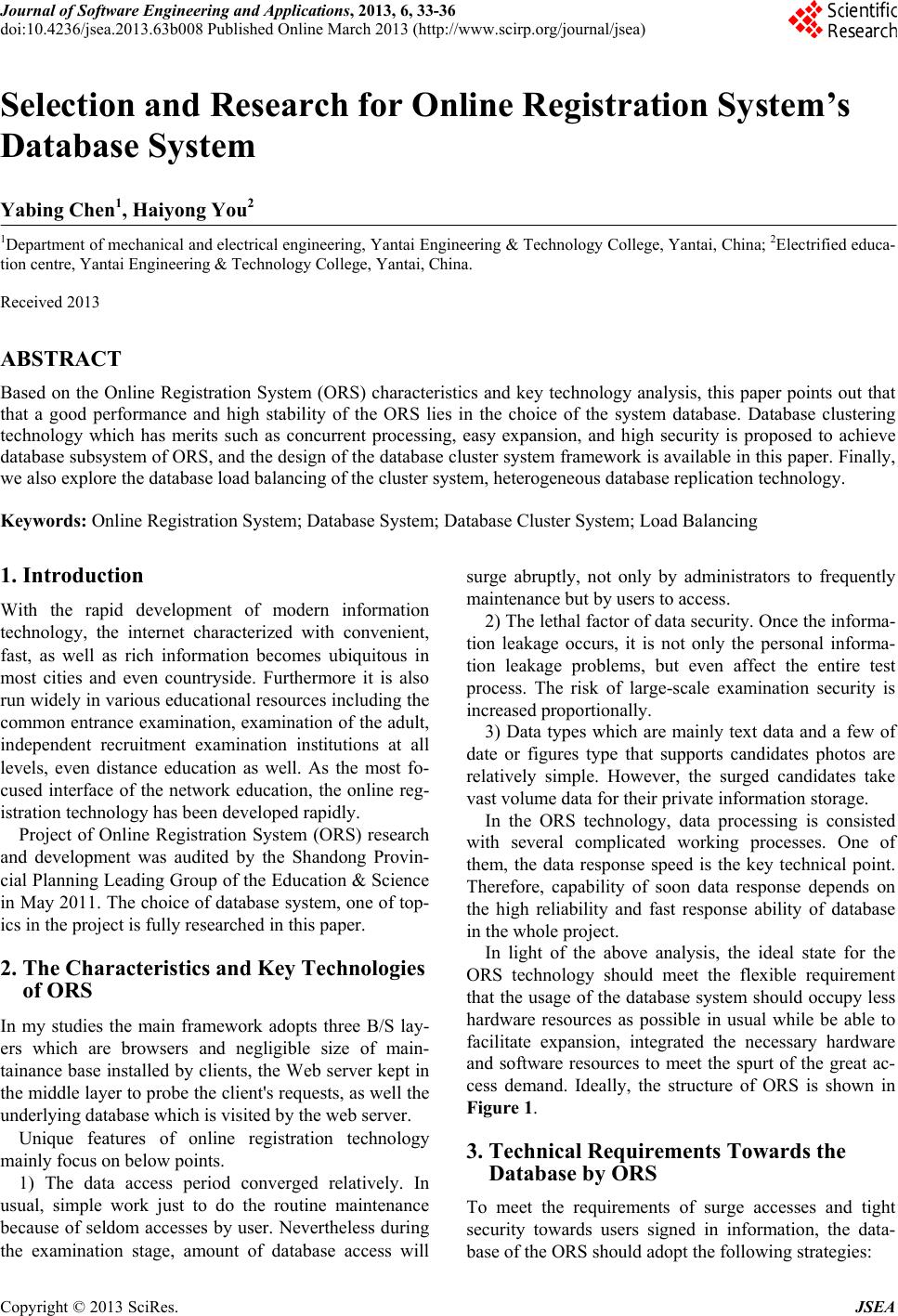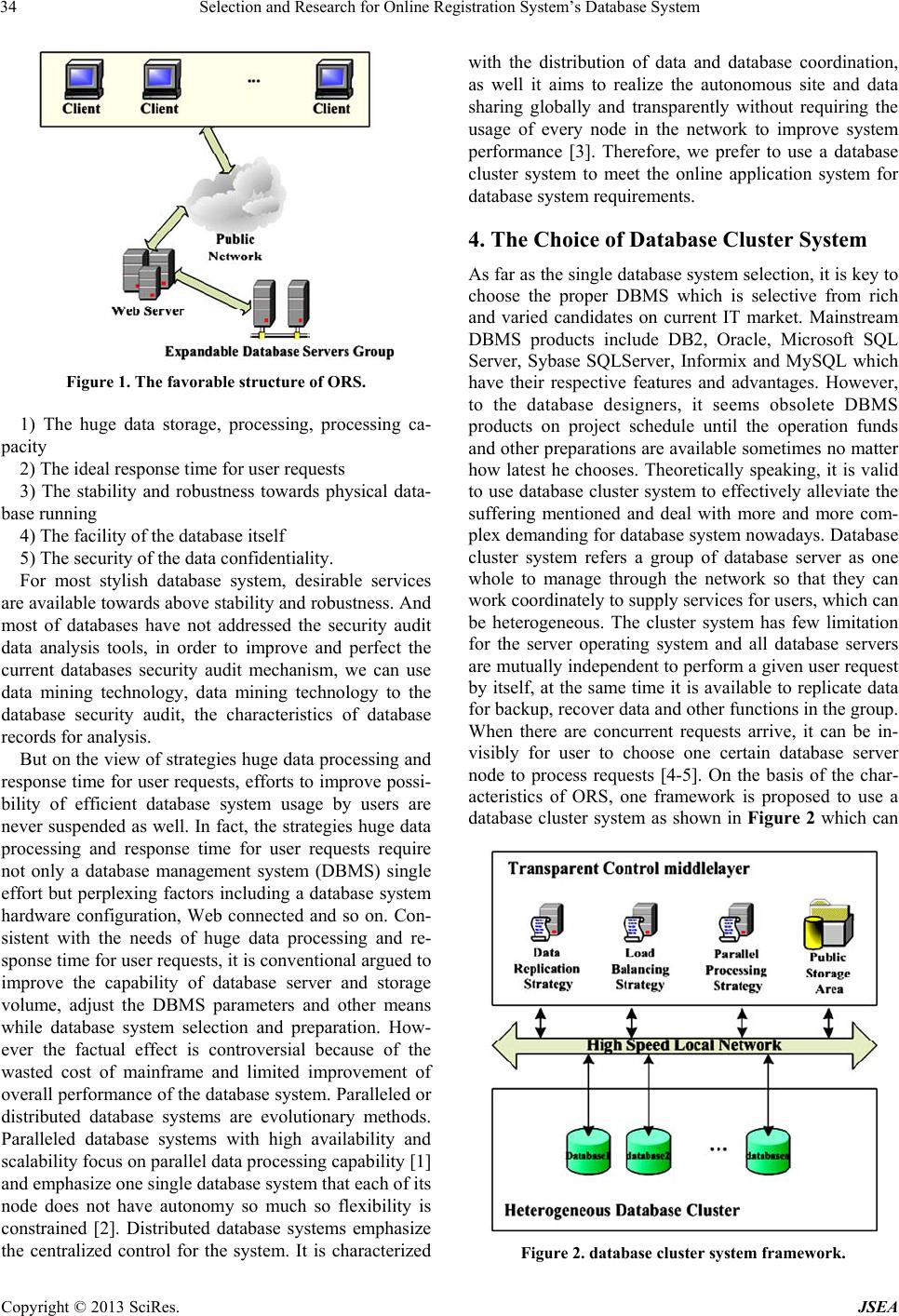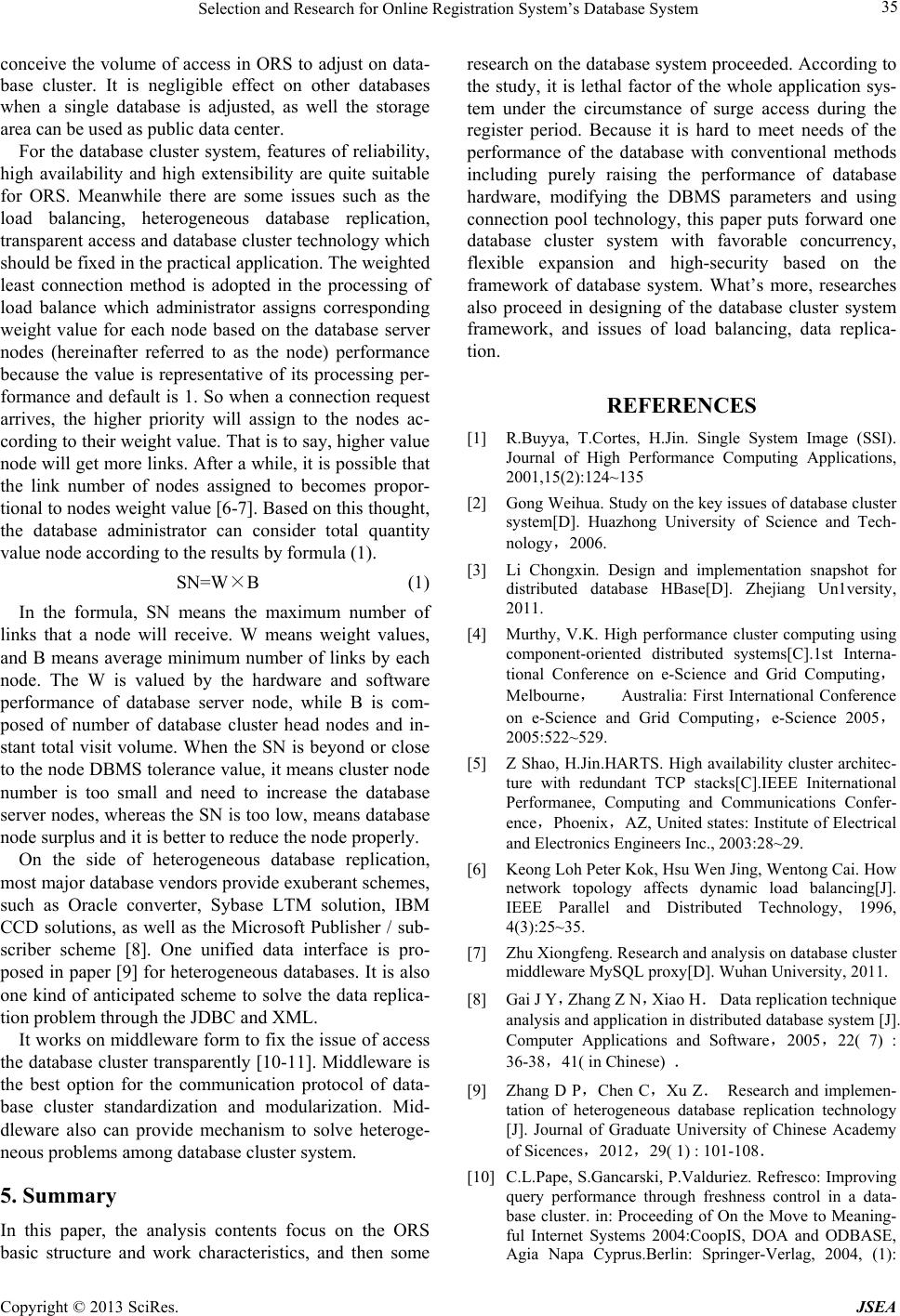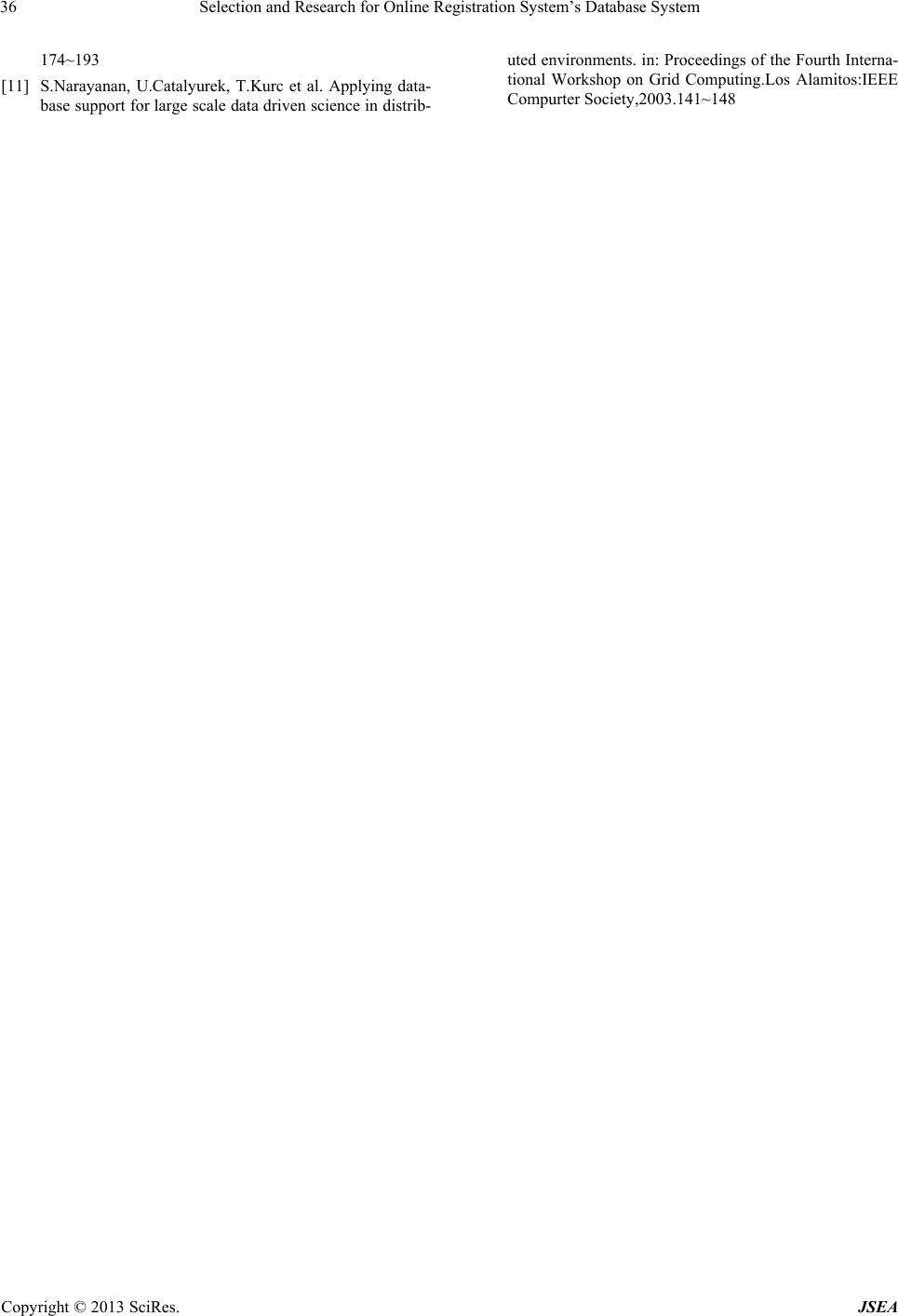Paper Menu >>
Journal Menu >>
 Journal of Software Engineering and Applications, 2013, 6, 33-36 doi:10.4236/jsea.2013.63b008 Published Online March 2013 (http://www.scirp.org/journal/jsea) Copyright © 2013 SciRes. JSEA 33 Selection and Research for Online Registration System’s Database System Yabing Chen1, Haiyong You2 1Department of mechanical and electrical engineering, Yantai Engineering & Technology College, Yantai, China; 2Electrified educa- tion centre, Yantai Engineering & Technology College, Yantai, China. Received 2013 ABSTRACT Based on the Online Registration System (ORS) characteristics and key technology analysis, this paper points out that that a good performance and high stability of the ORS lies in the choice of the system database. Database clustering technology which has merits such as concurrent processing, easy expansion, and high security is proposed to achieve database subsystem of ORS, and the design of the database cluster system framework is available in this paper. Finally, we also explore the database load balancing of the cluster system, heterogeneous database replication technology. Keywords: Online Registration System; Database System; Database Cluster System; Load Balancing 1. Introduction With the rapid development of modern information technology, the internet characterized with convenient, fast, as well as rich information becomes ubiquitous in most cities and even countryside. Furthermore it is also run widely in various educational resources including the common entrance examination, examination of th e adult, independent recruitment examination institutions at all levels, even distance education as well. As the most fo- cused interface of the network education, the online reg- istration technology has been developed rapidly. Project of Online Registration System (ORS) research and development was audited by the Shandong Provin- cial Planning Leading Group of the Education & Science in May 2011. The choice of database system, one of top- ics in the project is fully researched in this paper. 2. The Characteristics and Key Technologies of ORS In my studies the main framework adopts three B/S lay- ers which are browsers and negligible size of main- tainance base installed by clients, the Web server kept in the middle layer to probe the client's requests, as well the underlyi ng database which is visit e d by the web server. Unique features of online registration technology mainly focus on below points. 1) The data access period converged relatively. In usual, simple work just to do the routine maintenance because of seldom accesses by user. Nevertheless during the examination stage, amount of database access will surge abruptly, not only by administrators to frequently maintenance but by users to access. 2) The lethal factor of data security. Once the info rma- tion leakage occurs, it is not only the personal informa- tion leakage problems, but even affect the entire test process. The risk of large-scale examination security is increased proportionally. 3) Data types which are mainly text data and a few of date or figures type that supports candidates photos are relatively simple. However, the surged candidates take vast volume data for their private information storage. In the ORS technology, data processing is consisted with several complicated working processes. One of them, the data response speed is the key technical point. Therefore, capability of soon data response depends on the high reliability and fast response ability of database in the whole project. In light of the above analysis, the ideal state for the ORS technology should meet the flexible requirement that the usage of the database system should occupy less hardware resources as possible in usual while be able to facilitate expansion, integrated the necessary hardware and software resources to meet the spurt of the great ac- cess demand. Ideally, the structure of ORS is shown in Figure 1. 3. Technical Requirements Towards the Database by ORS To meet the requirements of surge accesses and tight security towards users signed in information, the data- base of the ORS should adopt the following strategies:  Selection and Research for Online Registration System’s Database System Copyright © 2013 SciRes. JSEA 34 Figure 1. The favorable structure of ORS. 1) The huge data storage, processing, processing ca- pacity 2) The ideal response time for user requests 3) The stability and robustness towards physical data- base runni ng 4) The facility of the database itself 5) The security of the data confidentiality. For most stylish database system, desirable services are available towards above stability an d robu stness. And most of databases have not addressed the security audit data analysis tools, in order to improve and perfect the current databases security audit mechanism, we can use data mining technology, data mining technology to the database security audit, the characteristics of database records for analysis. But on the view of strategies huge data processing and response time for user requests, efforts to improve possi- bility of efficient database system usage by users are never suspended as well. In fact, the strategies huge data processing and response time for user requests require not only a database management system (DBMS) single effort but perplexing factors including a database system hardware configuration, Web connected and so on. Con- sistent with the needs of huge data processing and re- sponse time for user requests, it is conventiona l argued to improve the capability of database server and storage volume, adjust the DBMS parameters and other means while database system selection and preparation. How- ever the factual effect is controversial because of the wasted cost of mainframe and limited improvement of overall performance of the database system. Paralleled or distributed database systems are evolutionary methods. Paralleled database systems with high availability and scalability focus on parallel data processing capability [1] and emphasize one single database system that each of its node does not have autonomy so much so flexibility is constrained [2]. Distributed database systems emphasize the centralized control for the system. It is characterized with the distribution of data and database coordination, as well it aims to realize the autonomous site and data sharing globally and transparently without requiring the usage of every node in the network to improve system performance [3]. Therefore, we prefer to use a database cluster system to meet the online application system for database system requirements. 4. The Choice of Database Cluster System As far as the single database system selection, it is key to choose the proper DBMS which is selective from rich and varied candidates on current IT market. Mainstream DBMS products include DB2, Oracle, Microsoft SQL Server, Sybase SQLServer, Informix and MySQL which have their respective features and advantages. However, to the database designers, it seems obsolete DBMS products on project schedule until the operation funds and other preparations are available sometimes no matter how latest he chooses. Theoretically speaking, it is valid to use database cluster system to effectively alleviate the suffering mentioned and deal with more and more com- plex demanding for database system nowadays. Database cluster system refers a group of database server as one whole to manage through the network so that they can work coordinately to supply services for users, wh ich can be heterogeneous. The cluster system has few limitation for the server operating system and all database servers are mutually independent to perform a given user request by itself, at the same time it is available to replicate data for backup, r eco ver data and o ther fu n ction s in th e group. When there are concurrent requests arrive, it can be in- visibly for user to choose one certain database server node to process requests [4-5]. On the basis of the char- acteristics of ORS, one framework is proposed to use a database cluster system as shown in Figure 2 which can Figure 2. database cluster system framework.  Selection and Research for Online Registration System’s Database System Copyright © 2013 SciRes. JSEA 35 conceive the volume of access in ORS to adjust on data- base cluster. It is negligible effect on other databases when a single database is adjusted, as well the storage area can be used as public data center. For the database cluster system, features of reliability, high availability and high extensibility are quite suitable for ORS. Meanwhile there are some issues such as the load balancing, heterogeneous database replication, transparent access and database cluster technology which should be fixed in the practical application. The weighted least connection method is adopted in the processing of load balance which administrator assigns corresponding weight value for each node based on the database server nodes (hereinafter referred to as the node) performance because the value is representative of its processing per- formance and default is 1. So when a connection request arrives, the higher priority will assign to the nodes ac- cording to their weight value. That is to say, higher valu e node will get more links. After a while, it is possible that the link number of nodes assigned to becomes propor- tional to nodes weigh t valu e [6-7]. Based on this th ought, the database administrator can consider total quantity value node according to the results by formula (1). SN=W×B (1) In the formula, SN means the maximum number of links that a node will receive. W means weight values, and B means average minimum number of links by each node. The W is valued by the hardware and software performance of database server node, while B is com- posed of number of database cluster head nodes and in- stant total visit volume. When the SN is beyond or close to the node DBMS tolerance v alue, it means cluster node number is too small and need to increase the database server nod es, whereas th e SN is too low, means database node surplus and it is better to reduce the node properly. On the side of heterogeneous database replication, most major database vendors provide exuberant schemes, such as Oracle converter, Sybase LTM solution, IBM CCD solutions, as well as the Microsoft Publisher / sub- scriber scheme [8]. One unified data interface is pro- posed in paper [9] for heterogeneous databases. It is also one kind of anticipated scheme to solve the data replica- tion problem through the JDBC and XML. It works on middleware form to fix the issue of access the database cluster transparently [10-11]. Middleware is the best option for the communication protocol of data- base cluster standardization and modularization. Mid- dleware also can provide mechanism to solve heteroge- neous problems among database cluster system. 5. Summary In this paper, the analysis contents focus on the ORS basic structure and work characteristics, and then some research on the database system proceeded. According to the study, it is lethal factor of the whole application sys- tem under the circumstance of surge access during the register period. Because it is hard to meet needs of the performance of the database with conventional methods including purely raising the performance of database hardware, modifying the DBMS parameters and using connection pool technology, this paper puts forward one database cluster system with favorable concurrency, flexible expansion and high-security based on the framework of database system. What’s more, researches also proceed in designing of the database cluster system framework, and issues of load balancing, data replica- tion. REFERENCES [1] R.Buyya, T.Cortes, H.Jin. Single System Image (SSI). Journal of High Performance Computing Applications, 2001,15(2):124~135 [2] Gong Weihua. Study on the key issues of database cluster system[D]. Huazhong University of Science and Tech- nology,2006. [3] Li Chongxin. Design and implementation snapshot for distributed database HBase[D]. Zhejiang Un1versity, 2011. [4] Murthy, V.K. High performance cluster computing using component-oriented distributed systems[C].1st Interna- tional Conference on e-Science and Grid Computing, Melbourne, Australia: First International Conference on e-Science and Grid Computing,e-Science 2005, 2005:522~529. [5] Z Shao, H.Jin.HARTS. High availability cluster architec- ture with redundant TCP stacks[C].IEEE Initernational Performanee, Computing and Communications Confer- ence,Phoenix,AZ, United states: Institute of Electrical and Electronics Engineers Inc., 2003:28~29. [6] Keong Loh Peter Kok, Hsu Wen Jing, Wentong Cai. How network topology affects dynamic load balancing[J]. IEEE Parallel and Distributed Technology, 1996, 4(3):25~35. [7] Zhu Xiongfeng. Research and analysis on database cluster middleware MySQL proxy[D]. Wuhan University, 2011. [8] Gai J Y,Zhang Z N,Xiao H. Data replication technique analysis and application in distributed database system [J]. Computer Applications and Software,2005,22( 7) : 36-38,41( in Chinese) . [9] Zhang D P,Chen C,Xu Z. Research and implemen- tation of heterogeneous database replication technology [J]. Journal of Graduate University of Chinese Academy of Sicences,2012,29( 1) : 101-108. [10] C.L.Pape, S.Gancarski, P.Valduriez. Refresco: Improving query performance through freshness control in a data- base cluster. in: Proceeding of On the Move to Meaning- ful Internet Systems 2004:CoopIS, DOA and ODBASE, Agia Napa Cyprus.Berlin: Springer-Verlag, 2004, (1):  Selection and Research for Online Registration System’s Database System Copyright © 2013 SciRes. JSEA 36 174~193 [11] S.Narayanan, U.Catalyurek, T.Kurc et al. Applying data- base support for large scale data driven science in distrib- uted environments. in: Proceedings of the Fourth Interna- tional Workshop on Grid Computing.Los Alamitos:IEEE Compurter Society,2003.141~148 |

